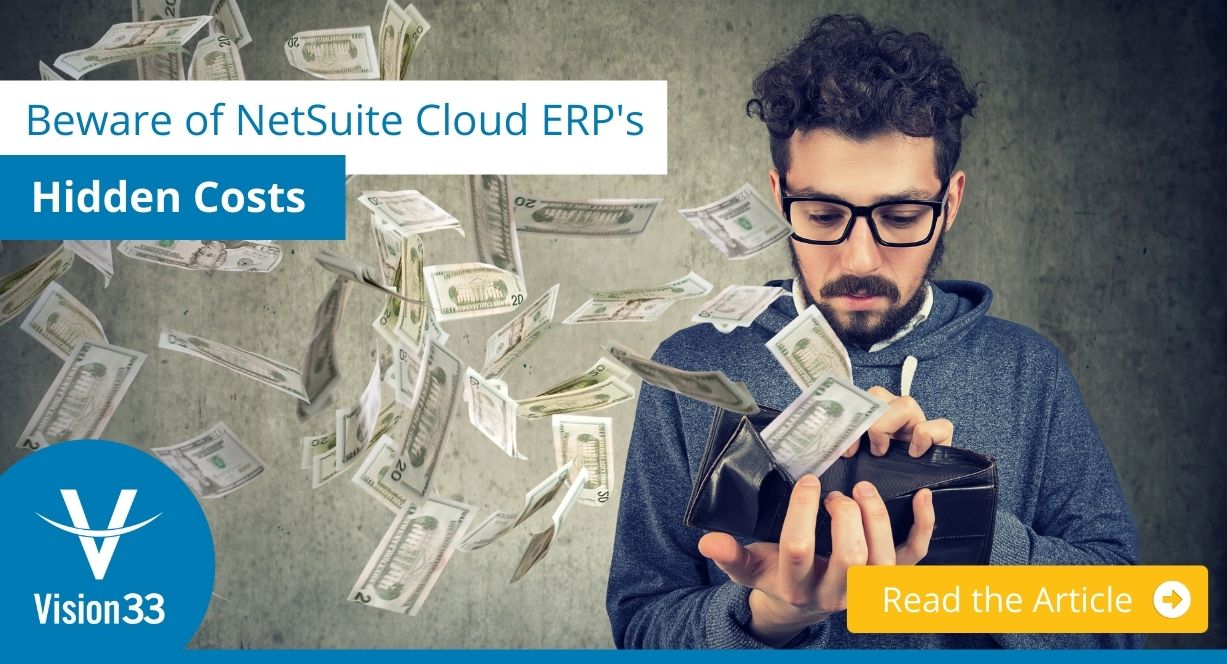Evaluating Cloud ERP Solutions: Why SAP Business One Triumphs Over NetSuite
SAP Business OneGet the insights you need to make an informed cloud ERP decision in our live webinar discussing SAP...

May 07, 2019
Blog > Beware of NetSuite Cloud ERP's Hidden Costs
When choosing a new enterprise resource planning (ERP) solution for your business, cloud deployment offers many advantages over on-premises deployment – simplified IT, better security, and a lower total cost of ownership. And for businesses with a limited budget, cost is crucial when choosing an ERP solution.
But you shouldn't jump for the first inexpensive price tag you see. If the initial price looks too good to be true, it probably is. Many businesses are surprised to learn about the hidden costs of ERP solutions such as NetSuite.
Consider these areas before using price as the deciding factor for your next cloud ERP solution.
Your chosen cloud ERP solution may not be as robust as you think. One way vendors can offer low initial costs is by removing basic out-of-the-box features and selling them as add-ons. The NetSuite starter edition, for example, is a very scaled-down cloud ERP that offers financial features but not much else. The features you expect, like customer relationship management (CRM), are available only as add-ons; getting them requires purchasing more software to fill the gaps, which increases the price.
Sometimes it’s difficult to anticipate what you’ll need as your business grows. A barebones cloud ERP solution may look cost-effective, but the costs of change requests and new features add up quickly. SAP Business One Cloud offers a robust system from the get-go, including many of the essential business features you’ll need today and tomorrow. You can ‘turn-on’ the modules and business functions when you need them without change requests, additional software vendors, or substantial modification to the initial system configuration.
Another hidden cost of cloud-based ERP implementation is software integration. It’s crucial to consider the underlying ERP solution for your cloud-based ERP implementation, as not all solutions are equal. NetSuite charges customers on a connection basis and can’t connect to apps that aren’t native to the core NetSuite ERP solution (e.g., e-commerce sites and electronic data interchange) without third-party partners and expensive middleware platforms. The result? Mounting prices.
If you choose SAP Business One Cloud offered by Vision33, you get the benefits of working with a single ERP partner for the entirety of your ERP implementation, which reduces the number of vendors and decreases the cost of the implementation. Vision33 enables integration between existing applications and SAP Business One with The Saltbox Platform, a born-in-the cloud Integration Platform as a Service (iPaaS) solution for enterprise integration, workflow and collaboration between business applications. Integrating SAP Business One with your other mission-critical systems will eliminate repetitive data entry, ensure accuracy, and allow you transfer data back and forth at lightning speed.
SAP Business One Cloud powered by AWS is an affordable ERP solution that scales as your business grows, allowing you to run smarter and drive profit. From financials and sales to inventory and production, SAP Business One Cloud gives you real-time business information from all areas of your company, allowing you to make smarter decisions – anywhere, any time.
Vision33 is the only SAP Business One partner worldwide that holds the AWS SAP Competency. With Vision33 as your global SAP Business One Cloud implementation partner, you can lean on our team to maximize your investment and take advantage of available features.
We created SAP Business One vs. NetSuite: The Ultimate Comparison Guide so you can compare the two solutions in terms of pricing, industry customization, performance and more. Download your copy below!
Subscribe to our newsletter to receive our latest blog posts, case studies and ERP news delivered straight to your inbox.
Get the insights you need to make an informed cloud ERP decision in our live webinar discussing SAP...
Here are 5 reasons SAP Business One is the preferred cloud ERP solution for growing businesses—and...
Struggling with data silos, disorganized systems, and inaccurate financial management? You’re...
Recieve our latest blog posts, case studies, and ERP news
delivered straight to your inbox.